The Liu Kang Collection: A Portrait of the Artist as a Young Man
The Liu Kang Collection at the National Library Singapore provides an intimate look at the creative process of one of Singapore’s most celebrated artists.
By Goh Yu Mei and Nadia Ramli
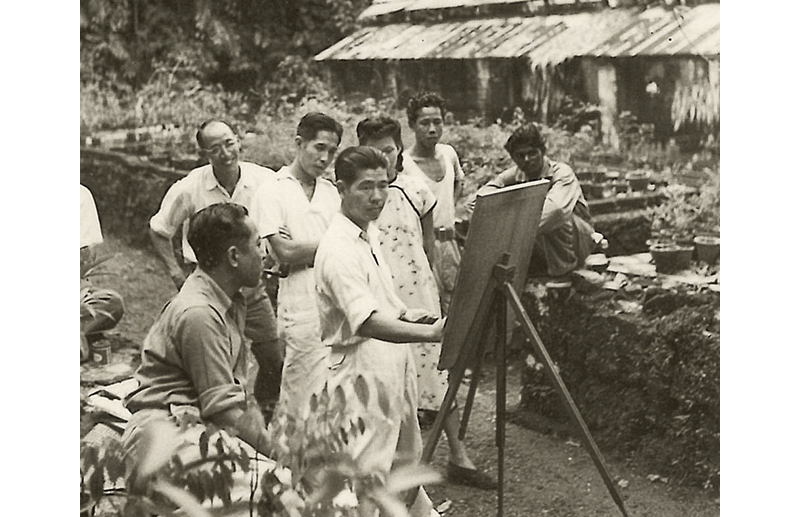
One of Singapore’s pioneering artists, Liu Kang (1911–2004) played a significant role in the development of the Singapore art scene. He, together with many of his contemporaries – such as Chen Chong Swee, Chen Wen Hsi and Cheong Soo Pieng – had turned to Southeast Asian subjects as inspiration for their artworks.
Influenced by both Eastern and Western art traditions, these artists also experimented and developed new art forms. Art historians have noted this trend, now commonly known as Nanyang art or Nanyang style, as one of the most significant movements in the history of art in Singapore.
“Nanyang” (南洋), literally the “South Seas”, was historically used to refer to the maritime region south of China, and more commonly to Southeast Asia in the early 20th century. In 1979, art historian T.K. Sabapathy remarked that the Nanyang artists “adopted an experimental approach by using styles and techniques derived from two sources: Chinese pictorial traditions and the School of Paris”.1 (The School of Paris refers to artists living and working in Paris in the early 20th century who employed a diversity of styles and techniques such as Fauvism, Cubism and Expressionism.2)
Liu Kang was one of the artists closely associated with the development of this art trend in Singapore, what he termed “equatorial style”. He recognised the need for original expressions of art in colonial and post-colonial Malaya, and a new style of painting that captured the spirit of the tropics.3
The Liu Kang Collection
In 2017, the family of the late Liu Kang donated to the National Library Singapore more than 7,000 items that belonged to him. Dating from the 1920s to the 2000s, these include books; correspondences; ephemera such as postcards and posters; manuscripts; and personal documents and photographs – providing insights into the life and legacy of one of Singapore’s pioneering artists.
Liu Kang’s interest in photography is evident from the huge volume of photographs in the collection. These show him working in his studio; his sketching trips; his students and fellow teachers in schools he had taught at; his gatherings with other artists; the activities of art societies; and the exhibitions that he had organised, participated or visited.
There are also items such as the catalogue, guest book and invitation card to his first solo exhibition in 1957; notes for his public talks and lectures; his letters and correspondences detailing some of the preparatory work that went into the organising of exhibitions for overseas artists; and his autobiographical article.
Guestbook and invitation card for Liu Kang’s first solo exhibition in 1957
Liu Kang held his first solo exhibition, 刘抗先生作画三十年纪念展览会, at the Victoria Memorial Hall from 7 to 15 December 1957, when he was 46 years old. The exhibition commemorated the 30th anniversary of his artistic journey.
The invitation card to the exhibition’s opening featured a sketch of a sculptor at work, which is likely to be inspired by Liu Kang’s trip to Bali in 1952. It provided details on the date, time and venue of the opening ceremony, and the guest-of-honour – the well-known businessman and philanthropist Lee Kong Chian.
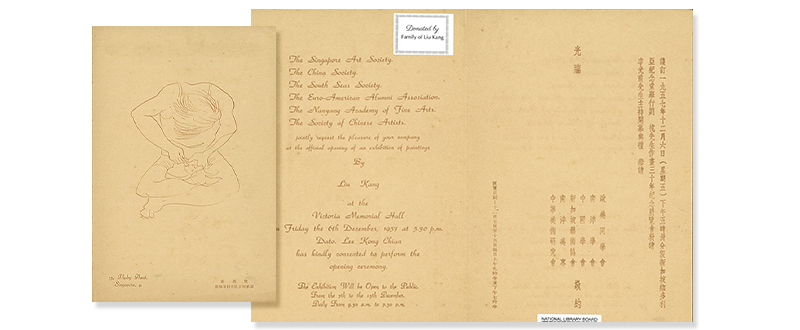
Similar information on the opening ceremony was recorded on the first leaf of the guestbook. It is a red accordion-style book that has a fabric cover with dragon motifs. Many personalities from Singapore’s cultural sphere attended the event. The guests who signed the guestbook included artists such as Chen Chong Swee, Huang Pao Fang, Lim Tze Peng and Wee Beng Chong as well as other critics, historians, writers and art collectors.

Draft of Liu Kang’s first solo exhibition catalogue in 1957
The draft of Liu Kang’s first solo exhibition catalogue includes an introduction by Lee Siow Mong, president of the China Society, and an essay by Michael Sullivan, curator of the University of Malaya’s art museum. The draft offers a glimpse into Liu’s creative process and evolution of design ideas leading up to the printed exhibition catalogue.

Photographs of the exhibition, “Bali: Liu Kang, Chen Wen Hsi, Chen Chong Swee, Cheong Soo Pieng” held at the British Council in 1953
In 1952, Liu Kang, together with Chen Chong Swee, Chen Wen Hsi and Cheong Soo Pieng, went to Java and Bali in search of artistic inspiration. A year later, in November 1953, the four men held a seminal joint exhibition at the British Council. This exhibition has been viewed as a “turning point” for the history of modern art in Singapore. Art historians Jeffrey Say and Seng Yu Jin noted its “new visual language that was distinctly modern in the local context”.4 This new visual language refers to the experimentations in artistic styles that would retrospectively be viewed as exemplifying Nanyang art.
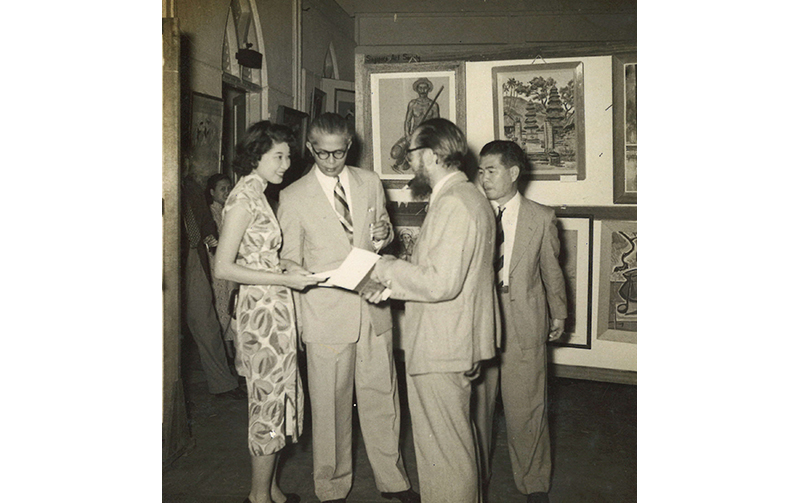
The exhibition, which showcased over 100 paintings and sketches, was well received and drew large crowds. Opened by Indonesian Consul-General Mohamed Razif, the exhibition was visited by prominent figures in Singapore, including Malcolm MacDonald, Commissioner-General in Southeast Asia; Carl Alexander Gibson-Hill, the last expatriate director of the Raffles Museum; and Loke Wan Tho, cinema magnate and founder of Cathay Organisation, and his wife.5
《说自家》(On Myself), an autobiographical article by Liu Kang
Liu Kang’s autobiographical article is titled《说自家》(On Myself). This 18-page manuscript offers a deeply personal and introspective look at the artist’s life as he shares his perspectives and recollections of his years in Paris. It was probably written in the early 1950s, making this the earliest known account by Liu Kang on the beginning of his art journey.
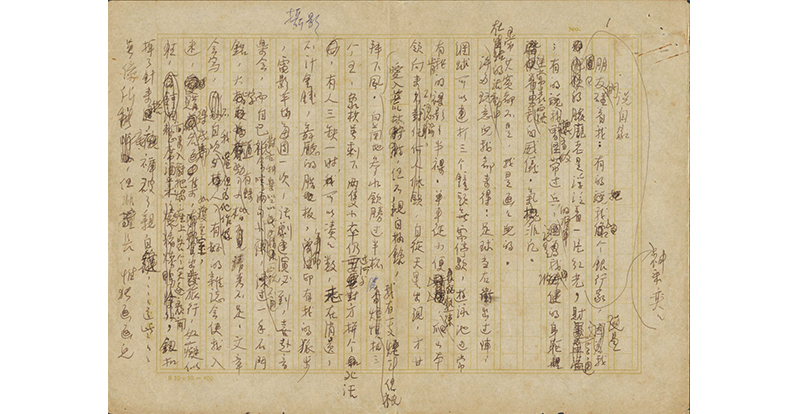
In the opening lines of the autobiographical article, Liu Kang offered a candid and revealing portrait of himself. He wrote that he saw himself more as a teacher than an artist, as he spent much of his time in the classrooms rather than on his own art. Liu Kang also recalled moments in his life that may have contributed to his art.
Liu Kang was also known for writing on various topics in relation to the arts, beside articles on fine art and other artists. In particular, his anthology of essays,《刘抗文集》(Essays by Liu Kang), first published in 1981 in conjunction with his retrospective exhibition, covers music, dance, literature and medical science among others.6 Many of his manuscripts and clippings of his articles, which are not published in the anthology, form part of his collection donated to the National Library.
Notes of Liu Kang’s public lectures
Liu Kang wrote notes for his public talks, some of which were published in newspapers and in the 1981 anthology. Not all the transcripts of his talks have been published. Fortunately, the notes for three of his talks have been donated to the National Library, providing insights into his thought process.
These are notes for “A Good Piece of Painting” (Young Men’s Christian Association; 25 January 1972), “On Oil Painting” (National Library; 17 June 1972) and “How to Appreciate a Painting” (early 1980s). In the notes for “On Oil Painting”, Liu Kang wrote that copying the masterpieces of well-known artists as practice would help to improve one’s art skills and that one could start with sketching sculptures, still life, landscapes and portraits.
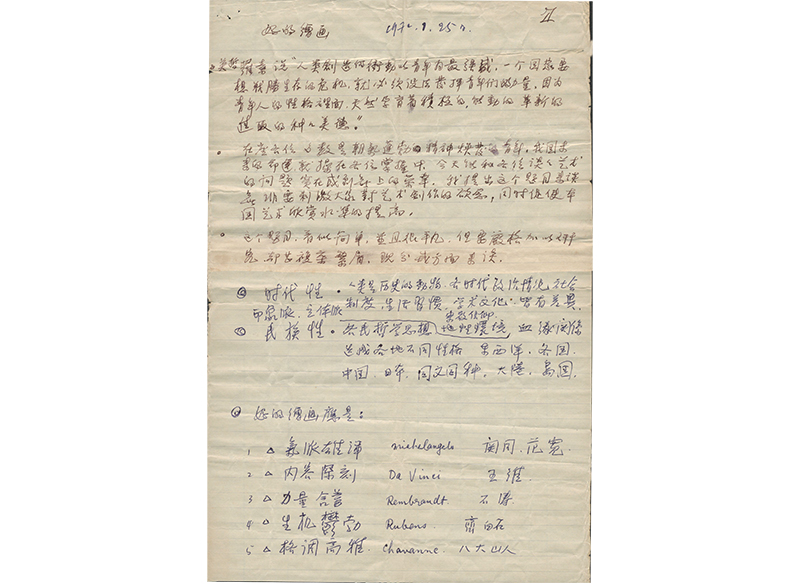
These notes provide us with a better understanding of Liu Kang’s views on art, and the guiding principles of his creative process.
Photographs of Han Wai Toon’s rambutan orchard, Yu Qu Yuan (愚趣园)
Han Wai Toon, a collector and expert in antique ceramics, held frequent gatherings at his residence and rambutan orchard on Thomson Road – Yu Qu Yuan (愚趣园; Garden of Foolish Indulgence). The Chinese literati and scholars would meet to enjoy fresh rambutans and appreciate his collection of ceramics, and ink and calligraphic works. Liu Kang was one of the visitors to the orchard. Besides his knowledge on antique ceramics, Han was also known for his rambutans grown with special grafting techniques that he had experimented with.
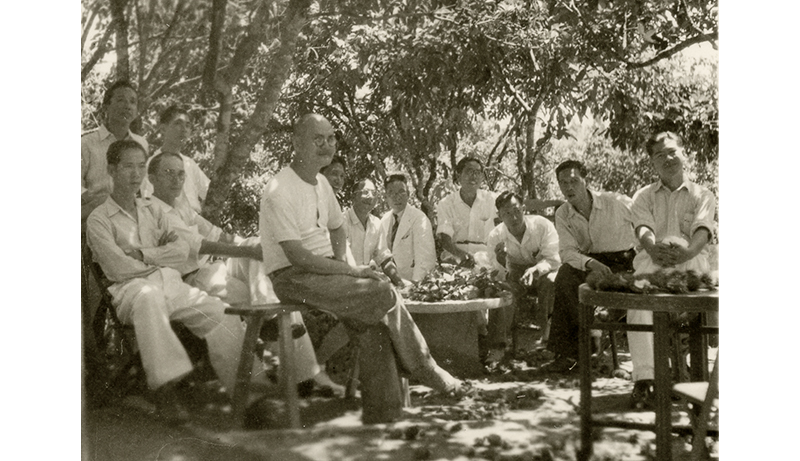
Other notable guests included the Chinese artist Xu Beihong (徐悲鸿), who dedicated a painting of rambutans to Han, and writer Yu Dafu (郁达夫), who wrote “不辞客路三千里,来啖红毛五月丹” (Travelling three thousand li just to taste rambutans in May). When Han returned to China in 1962, his friends commissioned a work by the artist Lim Mu Hue titled Han Rambutan Orchard as a farewell gift.7
Photographs of Chung Cheng High School graduation trip in 1948
Liu Kang taught art in schools for most of his working life in Singapore. In 1948, he led the graduating batch of senior high students from Chung Cheng High School on a three-week trip to the Malay Peninsula, visiting various towns and cities such as Muar, Melaka, Cameron Highlands, Ipoh and Penang. Several of the photos taken during the trip show Liu Kang with a sketchbook.
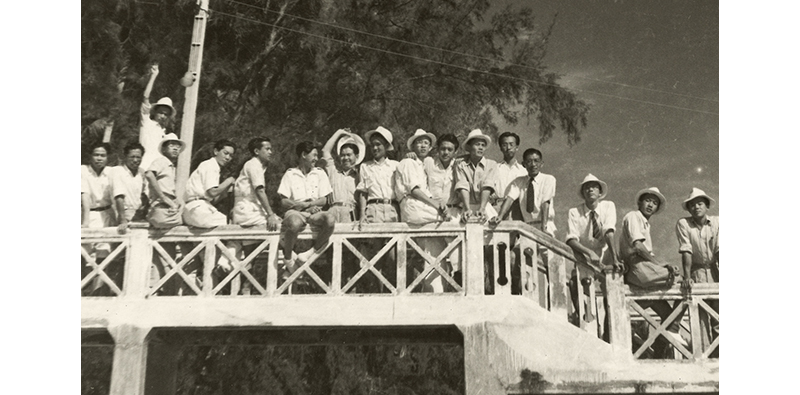
Photographs of Liu Kang painting Liu Haisu’s portrait in 1987
Liu Haisu (刘海粟) was a prominent Chinese painter who became acquainted with Liu Kang in the 1920s when the latter was enrolled at the Shanghai Art Academy. Liu Haisu was then the principal of the academy. Later, when Liu Kang was studying art in Paris in 1928, Liu Haisu went on a study trip to Europe and asked Liu Kang along. In 1932, Liu Haisu invited Liu Kang to teach art at the academy.
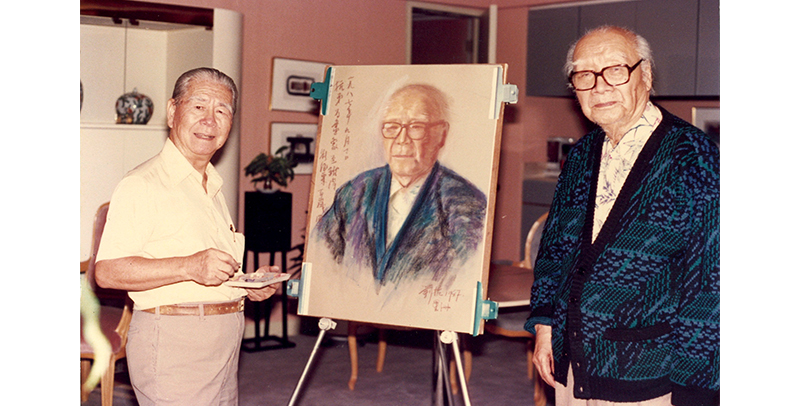
After Liu Kang left Shanghai in 1937, the two men remained in contact despite the political turmoil in Southeast Asia and China. In 1987, Liu Haisu visited Singapore for his exhibition that Liu Kang had helped coordinate. These photographs captured a private moment that was not reported in the newspapers. Liu Kang had painted a pastel portrait of Liu Haisu, and the latter in turn inscribed on the portrait the Chinese text “抗弟为画像至难得” (meaning that it was rare that Liu Kang had drawn a portrait of him).
Photographs from Liu Kang’s trip to India in 1971
Liu Kang was also an avid photographer and traveller. On his sketching trips, he often took photographs to capture the subjects and motifs that inspired him, and subsequently his paintings.
The photographs taken during Liu Kang’s visit to India in 1971 with more than 20 other prominent Singapore artists capture the people and culture of the country.8 Led by Yeh Chi Wei, president of the Southeast Asia Art Society, the cultural trip was part of a month-long tour across 17 cities in India, Nepal, Thailand and Burma.9 “Besides visiting scenic spots and admiring great architecture, our greatest wish was to use its rich spirit and majestic styles as a source of inspiration and reference for our artistic creation,” Liu Kang wrote in his essay, “I Love India”.10
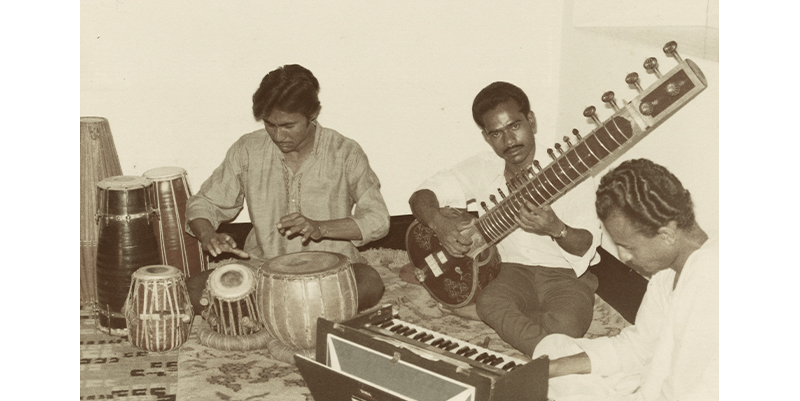
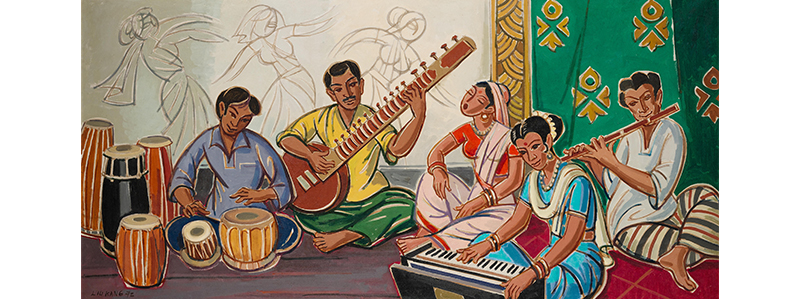
Prints of Liu Kang’s commissioned sketches of Raffles Hotel staff
In 1993, the Raffles Hotel commissioned Liu Kang to create a collection of pastel portraits of its staff. He drew more than 20 sketches, eight of which were chosen to be exhibited at the hotel’s museum in 1994, along with some of Liu Kang’s artworks.11
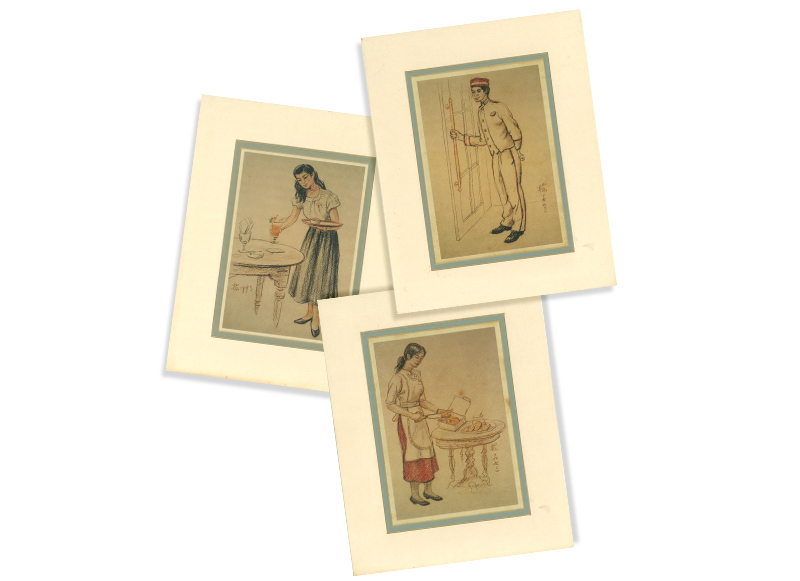
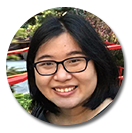 Goh Yu Mei is a Librarian with the National Library Singapore, working with the Chinese Arts and Literary Collection. Her research interests lie in the intersection between society, and Chinese literature and arts.
Goh Yu Mei is a Librarian with the National Library Singapore, working with the Chinese Arts and Literary Collection. Her research interests lie in the intersection between society, and Chinese literature and arts.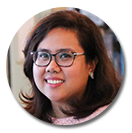 Nadia Ramli is a Senior Librarian (Outreach) with the National Library Singapore. She writes about the visual and literary arts, and has conducted numerous outreach programmes advocating information literacy.
Nadia Ramli is a Senior Librarian (Outreach) with the National Library Singapore. She writes about the visual and literary arts, and has conducted numerous outreach programmes advocating information literacy.NOTES
-
T.K. Sabapathy, “The Nanyang Artists: Some General Remarks,” in Pameran Retrospektif Pelukis-pelukis Nanyang (Kuala Lumpur: Muzium Seni Negara, 1979), 44. (From National Library Singapore, call no. RCLOS 759.959 PAM) ↩
-
James Voorhies, “School of Paris,” Heilbrunn Timeline of Art History, October 2004, http://www.metmuseum.org/toah/hd/scpa/hd_scpa.htm. ↩
-
Yeo Wei Wei, “Introduction,” in Liu Kang: Colourful Modernist (Singapore: National Art Gallery, Singapore, 2011), 15. (From National Library Singapore, call no. RSING 759.95957 LIU) ↩
-
Jeffrey Say and Seng Yu Jin, “The Modern and Its Histories in Singapore Art,” in Intersections, Innovations, Institutions: A Reader in Singapore Modern Art (Singapore: World Scientific Publishing Co. Pte. Ltd., 2023), 26. (From National Library Singapore, call no. RSING 709.595709034 INT) ↩
-
“Bali – By 4 Chinese Artists,” Straits Times, 10 November 1953, 2. (From NewspaperSG) ↩
-
刘抗 Liu Kang,《刘抗文集》[Essays by Liu Kang] (新加坡: 教育出版社, 1981). (From National Library Singapore, call no. RCLOS 709.2 LK) ↩
-
Lai Chee Kien, “Rambutans in the Picture: Han Wai Toon and the Articulation of Space by the Overseas Chinese in Singapore,” in Singapore in Global History, ed. Derek Heng and Syed Muhd Khairudin Aljunied (Amsterdam: Amsterdam University Press, 2011), 162, https://www.degruyter.com/document/doi/10.1515/9789048514373-010/html. ↩
-
“India Tour for Local Artists,” New Nation, 12 March 1971, 2. (From NewspaperSG) ↩
-
Ong Choo Suat, “Four-Nation Tour by Local Artists,” New Nation, 8 May 1971, 3. (From NewspaperSG) ↩
-
Liu Kang, “I Love India,” in Liu Kang: Essays on Art & Culture, ed. Sara Siew (Singapore: National Art Gallery, 2011), 197. (From National Library Singapore, call no. RSING 709.50904 LIU) ↩
-
“Liu Kang Puts Raffles’ Staff in Picture,” Straits Times Weekly Overseas Edition, 20 January 1994, 5. (From NewspaperSG) ↩

